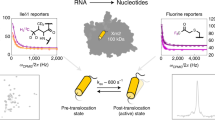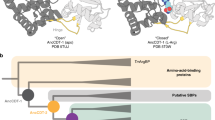Abstract
The question of whether protein motions play a role in the chemical step of enzymatic catalysis has generated much controversy in recent years. Debate has recently reignited over possible dynamic contributions to catalysis in dihydrofolate reductase, following conflicting conclusions from studies of the N23PP/S148A variant of the Escherichia coli enzyme. By investigating the temperature dependence of kinetic isotope effects, we present evidence that the reduction in the hydride transfer rate constants in this variant is not a direct result of impairment of conformational fluctuations. Instead, the conformational state of the enzyme immediately before hydride transfer, which determines the electrostatic environment of the active site, affects the rate constant for the reaction. Although protein motions are clearly important for binding and release of substrates and products, there appears to be no detectable dynamic coupling of protein motions to the hydride transfer step itself.
This is a preview of subscription content, access via your institution
Access options
Subscribe to this journal
Receive 12 print issues and online access
$259.00 per year
only $21.58 per issue
Buy this article
- Purchase on Springer Link
- Instant access to full article PDF
Prices may be subject to local taxes which are calculated during checkout


Similar content being viewed by others
References
Nagel, Z. D. & Klinman, J. P. A 21st century revisionist's view at a turning point in enzymology. Nature Chem. Biol. 5, 543–550 (2009).
Limbach, H-H., Schowen, K. B. & Schowen, R. L. Heavy atom motions and tunneling in hydrogen transfer reactions: the importance of the pre-tunneling state. J. Phys. Org. Chem. 23, 586–605 (2010).
Allemann, R. K., Evans, R. M. & Loveridge, E. J. Probing coupled motions in enzymatic hydrogen tunnelling reactions. Biochem. Soc. Trans. 37, 349–353 (2009).
Masgrau, L. et al. Atomic description of an enzyme reaction dominated by proton tunneling. Science 312, 237–241 (2006).
Antoniou, D., Basner, J., Núñez, S. & Schwartz, S. D. Computational and theoretical methods to explore the relation between enzyme dynamics and catalysis. Chem. Rev. 106, 3170–3187 (2006).
Olsson, M. H. M., Parson, W. W. & Warshel, A. Dynamical contributions to enzyme catalysis: critical tests of a popular hypothesis. Chem. Rev. 106, 1737–1756 (2006).
McGeagh, J. D., Ranaghan, K. E. & Mulholland, A. J. Protein dynamics and enzyme catalysis: insights from simulations. Biochim. Biophys. Acta 1814, 1077–1092 (2011).
Kuznetsov, A. & Ulstrup, J. Proton and hydrogen atom tunnelling in hydrolytic and redox enzyme catalysis. Can. J. Chem. 77, 1085–1096 (1999).
Sutcliffe, M. J. & Scrutton, N. S. Enzymology takes a quantum leap forward. Phil. Trans. R. Soc. Lond. A 358, 367–386 (2000).
Pudney, C. R. et al. Evidence to support the hypothesis that promoting vibrations enhance the rate of an enzyme catalyzed H-tunneling reaction. J. Am. Chem. Soc. 131, 17072–17073 (2009).
Schwartz, S. D. & Schramm, V. L. Enzymatic transition states and dynamic motion in barrier crossing. Nature Chem. Biol. 5, 551–558 (2009).
Pineda, J. R. E. T., Antoniou, D. & Schwartz, S. D. Slow conformational motions that favor sub-picosecond motions important for catalysis. J. Phys. Chem. B 114, 15985–15990 (2010).
Henzler-Wildman, K. & Kern, D. Dynamic personalities of proteins. Nature 450, 964–972 (2007).
Doll, K. M. & Finke, R. G. A compelling experimental test of the hypothesis that enzymes have evolved to enhance quantum mechanical tunneling in hydrogen transfer reactions: the beta-neopentylcobalamin system combined with prior adocobalamin data. Inorg. Chem. 42, 4849–4856 (2003).
Doll, K. M., Bender, B. R. & Finke, R. G. The first experimental test of the hypothesis that enzymes have evolved to enhance hydrogen tunneling. J. Am. Chem. Soc. 125, 10877–10884 (2003).
Kamerlin, S. C. L. & Warshel, A. An analysis of all the relevant facts and arguments indicates that enzyme catalysis does not involve large contributions from nuclear tunneling. J. Phys. Org. Chem. 23, 677–684 (2010).
Pisliakov, A. V., Cao, J., Kamerlin, S. C. L. & Warshel, A. Enzyme millisecond conformational dynamics do not catalyze the chemical step. Proc. Natl Acad. Sci. USA 106, 17359–17364 (2009).
Romesberg, F. E. & Schowen, R. L. Isotope effects and quantum tunneling in enzyme-catalyzed hydrogen transfer. Part I. The experimental basis. Adv. Phys. Org. Chem. 39, 27–77 (2004).
Liu, H. & Warshel, A. Origin of the temperature dependence of isotope effects in enzymatic reactions: the case of dihydrofolate reductase. J. Phys. Chem. B 111, 7852–7861 (2007).
Wu, Y. D. & Houk, K. Theoretical transition structures for hydride transfer to methyleneiminium ion from methylamine and dihydropyridine. On the nonlinearity of hydride transfers. J. Am. Chem. Soc. 109, 2226–2227 (1987).
Loveridge, E. J. & Allemann, R. K. Effect of pH on hydride transfer by Escherichia coli dihydrofolate reductase. ChemBioChem 12, 1258–1262 (2011).
Sikorski, R. S. et al. Tunneling and coupled motion in the Escherichia coli dihydrofolate reductase catalysis. J. Am. Chem. Soc. 126, 4778–4779 (2004).
Kohen, A., Cannio, R., Bartolucci, S. & Klinman, J. P. Enzyme dynamics and hydrogen tunnelling in a thermophilic alcohol dehydrogenase. Nature 399, 496–499 (1999).
Chowdhury, S. & Banerjee, R. Evidence for quantum mechanical tunneling in the coupled cobalt–carbon bond homolysis-substrate radical generation reaction catalyzed by methylmalonyl-CoA mutase. J. Am. Chem. Soc. 122, 5417–5418 (2000).
Fan, F. & Gadda, G. Oxygen-and temperature-dependent kinetic isotope effects in choline oxidase: correlating reversible hydride transfer with environmentally enhanced tunneling. J. Am. Chem. Soc. 127, 17954–17961 (2005).
Anandarajah, K. & Schowen, K. Hydrogen tunneling in glucose oxidation by the archaeon Thermoplasma acidophilum. Z. Phys. Chem. 222, 1333–1347 (2008).
Hay, S., Pudney, C. R. & Scrutton, N. S. Structural and mechanistic aspects of flavoproteins: probes of hydrogen tunnelling. FEBS J. 276, 3930–3941 (2009).
Heyes, D. J., Sakuma, M., de Visser, S. P. & Scrutton, N. S. Nuclear quantum tunneling in the light-activated enzyme protochlorophyllide oxidoreductase. J. Biol. Chem. 284, 3762–3767 (2009).
Sawaya, M. R. & Kraut, J. Loop and subdomain movements in the mechanism of Escherichia coli dihydrofolate reductase: crystallographic evidence. Biochemistry 36, 586–603 (1997).
Bhabha, G. et al. A dynamic knockout reveals that conformational fluctuations influence the chemical step of enzyme catalysis. Science 332, 234–238 (2011).
Adamczyk, A. J., Cao, J., Kamerlin, S. C. L. & Warshel, A. Catalysis by dihydrofolate reductase and other enzymes arises from electrostatic preorganization, not conformational motions. Proc. Natl Acad. Sci. USA 108, 14115–14120 (2011).
Swanwick, R. S., Shrimpton, P. J. & Allemann, R. K. Pivotal role of Gly 121 in dihydrofolate reductase from Escherichia coli: the altered structure of a mutant enzyme may form the basis of its diminished catalytic performance. Biochemistry 43, 4119–4127 (2004).
Fierke, C. A., Johnson, K. A. & Benkovic, S. J. Construction and evaluation of the kinetic scheme associated with dihydrofolate reductase from Escherichia coli. Biochemistry 26, 4085–4092 (1987).
Maglia, G., Javed, M. H. & Allemann, R. K. Hydride transfer during catalysis by dihydrofolate reductase from Thermotoga maritima. Biochem. J. 374, 529–535 (2003).
Loveridge, E. J. et al. The role of large-scale motions in catalysis by dihydrofolate reductase. J. Am. Chem. Soc. 133, 20561–20570 (2011).
Arora, K. & Brooks, C. L. III Functionally important conformations of the Met20 loop in dihydrofolate reductase are populated by rapid thermal fluctuations. J. Am. Chem. Soc. 131, 5642–5647 (2009).
Osborne, M. J., Schnell, J., Benkovic, S. J., Dyson, H. J. & Wright, P. E. Backbone dynamics in dihydrofolate reductase complexes: role of loop flexibility in the catalytic mechanism. Biochemistry 40, 9846–9859 (2001).
Loveridge, E. J. & Allemann, R. K. The temperature dependence of the kinetic isotope effects of dihydrofolate reductase from Thermotoga maritima is influenced by intersubunit interactions. Biochemistry 49, 5390–5396 (2010).
Loveridge, E. J., Tey, L-H. & Allemann, R. K. Solvent effects on catalysis by Escherichia coli dihydrofolate reductase. J. Am. Chem. Soc. 132, 1137–1143 (2010).
Loveridge, E. J., Evans, R. M. & Allemann, R. K. Solvent effects on environmentally coupled hydrogen tunnelling during catalysis by dihydrofolate reductase from Thermotoga maritima. Chem. Eur. J. 14, 10782–10788 (2008).
Liu, H. & Warshel, A. The catalytic effect of dihydrofolate reductase and its mutants is determined by reorganization energies. Biochemistry 46, 6011–6025 (2007).
Swanwick, R. S., Maglia, G., Tey, L-H. & Allemann, R. K. Coupling of protein motions and hydrogen transfer during catalysis by Escherichia coli dihydrofolate reductase. Biochem. J. 394, 259–265 (2006).
Blakley, R. Crystalline dihydropteroylglutamic acid. Nature 188, 231–232 (1960).
Stone, S. R. & Morrison, J. F. Kinetic mechanism of the reaction catalyzed by dihydrofolate reductase from Escherichia coli. Biochemistry 21, 3757–3765 (1982).
Reijenga, J. C., Gagliardi, L. G. & Kenndler, E. Temperature dependence of acidity constants, a tool to affect separation selectivity in capillary electrophoresis. J. Chromatogr. A 1155, 142–145 (2007).
Acknowledgements
This work was supported by the UK Biotechnology and Biological Sciences Research Council (BBSRC) (grant no. BB/E008380/1) and by Cardiff University.
Author information
Authors and Affiliations
Contributions
E.J.L. performed the bulk of the experimental work. E.M.B. and J.G. performed additional experiments. E.J.L. and R.K.A. designed the experiments, analysed the data and wrote the manuscript. All authors commented on the manuscript.
Corresponding author
Ethics declarations
Competing interests
The authors declare no competing financial interests.
Supplementary information
Rights and permissions
About this article
Cite this article
Loveridge, E., Behiry, E., Guo, J. et al. Evidence that a ‘dynamic knockout’ in Escherichia coli dihydrofolate reductase does not affect the chemical step of catalysis. Nature Chem 4, 292–297 (2012). https://doi.org/10.1038/nchem.1296
Received:
Accepted:
Published:
Issue Date:
DOI: https://doi.org/10.1038/nchem.1296



